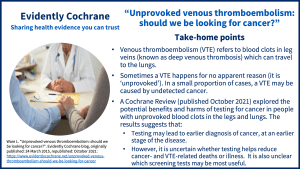In this guest blog, retired GP, Lynda Ware, looks at evidence for the management of an unprovoked venous thromboembolism, asking what are the benefits of intensive screening to look for an undiagnosed cancer?
Page originally published: 24 March 2015. Blog revised and republished: October 2021, to include updated evidence.
Page checked 12 July 2023
Take-home points

I have vivid memories of a young man, who presented to me in surgery with bilateral calf pain. He had been on holiday in the Channel Islands and had developed painful calves. He had visited a local GP twice, who thought his discomfort was muscular, caused by long walks on rocky beaches. The tragic truth was that he had bilateral deep vein thrombosis (DVT) and, on further investigation, extensive metastatic cancer. A few weeks later he was dead.
I think of him when reading a Cochrane ReviewCochrane Reviews are systematic reviews. In systematic reviews we search for and summarize studies that answer a specific research question (e.g. is paracetamol effective and safe for treating back pain?). The studies are identified, assessed, and summarized by using a systematic and predefined approach. They inform recommendations for healthcare and research. looking at venous thromboembolism (VTE) and its link to cancer: Effect of testing for cancer on cancer- or venous thromboembolism (VTE)-related mortality and morbidity in people with unprovoked VTE (updated October 2021).1

What do we know already?
The associationA relationship between two characteristics, such that as one changes, the other changes in a predictable way. For example, statistics demonstrate that there is an association between smoking and lung cancer. In a positive association, one quantity increases as the other one increases (as with smoking and lung cancer). In a negative association, an increase in one quantity corresponds to a decrease in the other. Association does not necessarily mean that one thing causes the other. between VTE and cancer was first described in 1823 by Jean Baptiste Bouillaud 2. In 1865 Armand Trousseau highlighted the association again, lending his name to the condition – Trousseau Syndrome 3. Sadly, Armand died in 1867 of the very condition he had identified two years earlier.
The most common cancers associated with VTE are prostate, colon, lung and brain in men and breast, lung and ovary in women. The commonest thromboembolic events are DVT and pulmonary embolus but they can also develop in less common sites such as arm or neck veins, the vena cavae or the visceral, portal or cerebral circulation 4.
What is the optimum treatment for VTE in cancer patients?
In the case of a cancer-linked DVT, NICE recommends offering anticoagulation treatmentSomething done with the aim of improving health or relieving suffering. For example, medicines, surgery, psychological and physical therapies, diet and exercise changes. for 3 to 6 months, sometimes longer. Choice of anticoagulation treatment for people with active cancer and confirmed proximal DVT or PE, “should take into account the tumour site, interactions with other drugs including those used to treat cancer, and the person’s bleeding risk”.6
Cancer patients are at higher riskA way of expressing the chance of an event taking place, expressed as the number of events divided by the total number of observations or people. It can be stated as ‘the chance of falling were one in four’ (1/4 = 25%). This measure is good no matter the incidence of events i.e. common or infrequent. of bleeding complications associated with vitamin K antagonists. Some studies have suggested that heparin and low-molecular-weight heparin (LMWH) may have antitumour effects. A systematic review 5 did not confirm this in patients with late-stage disease. The effect of LMWH on overall survival in patients with limited-stage disease is unknown.
Should we look for cancer in someone with a first episode of unprovoked VTE?
This has been addressed by the Cochrane Review Effect of testing for cancer on cancer- or venous thromboembolism (VTE)-related mortality and morbidity in people with unprovoked VTE. The review asked, “does testing for cancer in people with unprovoked blood clots in the legs and lungs reduce cancer- and blood clot-related death and illness?”
Here’s what the authors found:

Credit: Wellcome Images
The review includes four studies with 1644 participants. Two studies compared extensive cancer tests with tests carried out at the physician’s discretion and two studies compared cancer tests plus scanning with cancer tests alone.
The screening undertaken in the trialsClinical trials are research studies involving people who use healthcare services. They often compare a new or different treatment with the best treatment currently available. This is to test whether the new or different treatment is safe, effective and any better than what is currently used. No matter how promising a new treatment may appear during tests in a laboratory, it must go through clinical trials before its benefits and risks can really be known. was far more extensive than the 2020 NICE guideline recommends6, particularly in the one of the studies, where the list included endoscopy, barium swallow, tumour markers, ultrasound of prostate, PAP smear – to name but a few.
The results suggest that:
- those patients intensively screened may be more likely to have a cancer diagnosis earlier, at an earlier stage of the disease. The time to cancer diagnosis was shorter in tested patients with a mean of one month versus eleven months.
- However, there is currently insufficient evidence to say whether screening undiagnosed cancer has an impact on cancer- or VTE-related illness or deaths. There is also not enough information about possible side effects of testing or patient satisfaction.
What is the quality of this evidence?
When comparing extensive tests versus tests at the physician’s discretion, the certainty of the evidenceThe certainty (or quality) of evidence is the extent to which we can be confident that what the research tells us about a particular treatment effect is likely to be accurate. Concerns about factors such as bias can reduce the certainty of the evidence. Evidence may be of high certainty; moderate certainty; low certainty or very-low certainty. Cochrane has adopted the GRADE approach (Grading of Recommendations Assessment, Development and Evaluation) for assessing certainty (or quality) of evidence. Find out more here: https://training.cochrane.org/grade-approach was low. There was biasAny factor, recognised or not, that distorts the findings of a study. For example, reporting bias is a type of bias that occurs when researchers, or others (e.g. drug companies) choose not report or publish the results of a study, or do not provide full information about a study. caused by two of the studies stopping early.
When comparing tests plus PET/CT scanning with tests alone, the certainty of the evidence ranged from low to moderate. There were issues with how the studies were designed, imprecision caused by a low number of events, and bias due to lack of blindingBlinding is the process of preventing those involved in a trial from knowing to which comparison group a particular participant belongs. of people assessing the effects.
Where does this leave us?
Cancer is linked to a significantly increased risk of VTE and an unprovoked episode of venous thromboembolism is associated with a 10% risk of having cancer.
Intensive screening after an episode of unprovoked VTE may identify cancer earlier and at an earlier stage. However, there is insufficient evidence to assess whether it is effective in reducing cancer- and VTE- related deaths and illness. It is also unclear which screening tests are most useful.
There are important implications for patients and clinicians in earlier cancer diagnosis and the tailored treatment of cancer-related VTE. Further large, well-designed trials are needed to shed light on the underlying uncertainties.
Links:
- Robertson L, Broderick C, Yeoh SE, Stansby G. Effect of testing for cancer on cancer- or venous thromboembolism (VTE)-related mortality and morbidity in people with unprovoked VTE. Cochrane Database of Systematic ReviewsIn systematic reviews we search for and summarize studies that answer a specific research question (e.g. is paracetamol effective and safe for treating back pain?). The studies are identified, assessed, and summarized by using a systematic and predefined approach. They inform recommendations for healthcare and research. 2021, Issue 10. Art. No.: CD010837. DOI: 10.1002/14651858.CD010837.pub5.
- Bouillard JB, Bouillaud S. De l’Obliteration des veines et de son influence sur la formation des hydropisies partielles: consideration sur la hydropisies passive et general. Archives Générales de Médecine 1823;1(2):188–204. Available from: http://babel.hathitrust.org/cgi/pt?id=mdp.39015062233641;view=1up;seq=194
- Trousseau A. Phlegmasia alba dolens. Clinique Medicale de l’Hotel-Dieu de Paris. 2nd ed. Paris, France: The Sydenham Society;1865. p. 654–712.
- Lee AY, Levine MN. Venous thromboembolism and cancer: risks and outcomesOutcomes are measures of health (for example quality of life, pain, blood sugar levels) that can be used to assess the effectiveness and safety of a treatment or other intervention (for example a drug, surgery, or exercise). In research, the outcomes considered most important are ‘primary outcomes’ and those considered less important are ‘secondary outcomes’.. Circulation 2003:107
- Sandford D, Naidu A, Alizadeh N, Lazo-Langer A. The effect of LMWH on survival in cancer patients: an updated systematic review and meta-analysisThe use of statistical techniques in a systematic review to combine the results of included studies. Sometimes misused as a synonym for systematic reviews, where the review includes a meta-analysis. of randomisedRandomization is the process of randomly dividing into groups the people taking part in a trial. One group (the intervention group) will be given the intervention being tested (for example a drug, surgery, or exercise) and compared with a group which does not receive the intervention (the control group). trials. JTH 2014; 12 (7) 1076-1085
- National Institute for Health and Clinical Excellence. Venous thromboembolic diseases: diagnosis, management and thrombophilia testing. London: National Institute for Health and Clinical Excellence; 2020. (NICE NG 158). [Issued March 2020].


